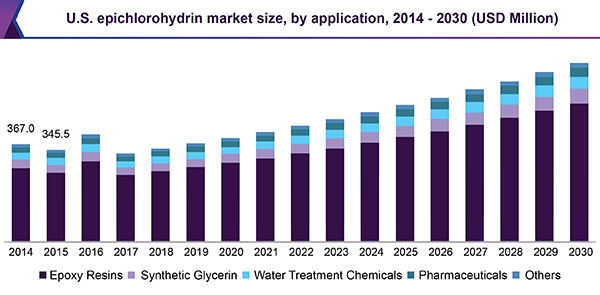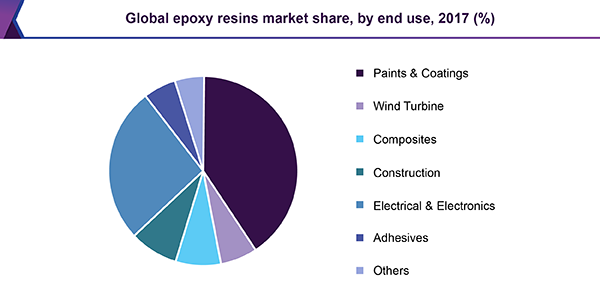- Home
- »
- Bulk Chemicals
- »
-
Global Epichlorohydrin Market Size, ECH Industry Report, 2018-2030GVR Report cover
![Epichlorohydrin Market Size, Share & Trends Report]()
Epichlorohydrin Market Size, Share & Trends Analysis Report By Application (Water Treatment Chemicals, Epoxy Resins, Synthetic Glycerin, Pharmaceuticals), By Region, And Segment Forecasts, 2018 - 2030
- Report ID: GVR-2-68038-547-2
- Number of Pages: 222
- Format: Electronic (PDF)
- Historical Range: 2014 - 2017
- Industry: Research
Report Overview
The global epichlorohydrin market size was estimated at USD 2.23 billion in 2017 and is anticipated to expand at a CAGR of 5.4% during the forecast period. Epoxy resins find application in a large number of end-use industries. Thus, rising demand for epoxy resins from various end-use industries such as building and construction, automotive, and renewable energy equipment is expected to be a major driving factor for the market. Paints and coatings is one of the largest end-use segment that uses epoxy resins in their formulations.

Economic growth in the emerging countries of Asia Pacific will lead to a rise in consumption of epoxy resin in paints and coatings, automotive, and building and construction sectors. Rise in private and public non-residential spending, as a result of increased employment opportunities, are improving the growth prospects for epoxy resins, thus benefitting the epichlorohydrin (ECH) market.
Largely, epichlorohydrin manufacturing uses propylene as a raw material. Rising penetration of bio-based products has forced manufacturers to use glycerin-based starting material. Numerous companies such as Dow Chemical Company, Samsung Fine Chemical, and Belgium’s Solvay SA have started the usage of renewable feedstock glycerin to manufacture ECH. Traditionally, epichlorohydrin was being manufactured in a multi-step procedure where propylene was used as the starting material.
High fluctuation in the prices of propylene coupled with increased production of raw glycerin, obtained as a by-product of biodiesel manufacturing, has increased the interest in processes where the glycerol is used as a raw material. Recently, the manufacturing of ECH has followed the “green” trend in the chemical industry by using sustainable engineering and environmentally friendly raw materials. Rising demand from the developing countries in Eastern Europe and Asia is augmenting the market growth.
These regions remain the major product importers. Moreover, advent of new technologies that are being applied in the polycarbonate and epoxy resin industries would also drive the epichlorohydrin market. Tight supply of ECH in the Asia Pacific is expected to continue as plants in China cut output to comply with environmental regulations in the country. An environmental clean-up program that was first propelled in 2016, but congregated much more speed from January 2017, has led to factory closures.
Application Insights
The major application segments for epichlorohydrin are epoxy resins, pharmaceuticals, water treatment chemicals, and synthetic glycerin. Epoxy resins produced from epichlorohydrin are used across multiple industries including adhesives, coatings, and plastics. These resins are also used to produce inks and dyes used in various end-use sectors. Whereas, synthetic glycerin is robustly used in the cosmetics industry and in commercial insecticides surfactants, solvents, pharmaceuticals, textiles, and paper sectors.
In the construction industry, epoxy resins are used to manufacture floorings in high traffic areas such as shopping malls, industrial buildings, and hospitals due to their anti-slip textures. They are also used to bind concrete to itself or to steel in monument restoration applications.

Epichlorohydrin has other multiple applications across diverse end-use industries, which include its use in ECH-based rubber, inks and dyes, paper, agricultural products (such as fungicides, insecticides, and bactericides), textiles, and ion-exchange resins among others. The current ECH production trend has typically shifted from its manufacturing through petroleum-based feedstock to bio-based feedstock, thereby switching from propylene to glycerin.
The agricultural residues are used extensively to prepare anion exchangers after they are reacted with ECH and dimethylamine. This holds specific importance, as agricultural residues anion exchangers can eliminate NO3 and increases yield at lower costs.
Regional Insights
North America was the second-largest regional market in 2017 with a volume-based market share of over 19%. Rising optimism in industries with high demand for chemical products is boosting demand for specialty chemicals. The U.S., the major consumer of epichlorohydrin in this region, has adopted a cautious approach for economic growth. The introduction of stricter laws against epichlorohydrin in Canada will lower the demand for epichlorohydrin. Capacity expansions and capital infusion are the major factors that are expected to play a major role in driving the demand for epichlorohydrin.
Asia Pacific was the largest regional market in 2017 with a global share of over 50% in terms of volume. The global dominance was mainly due to the presence of emerging countries such as China, Taiwan, and Malaysia, which are among the major consumers of epichlorohydrin. India and Taiwan markets are expected to grow rapidly over the coming years owing to rising demand from end-use industries such as building and construction and electronic manufacturing. The rise in petroleum refining activities coupled with increasing demand for epoxy resins is also expected to propel market growth in these regions.
Key Companies & Market Share Insights
The industry participants are majorly focusing on the development of capacity expansions and expanding the product portfolio. Most of the companies carry a wide range of product line catering to numerous end-use industries in different geographies maintaining the demand-supply balance. Dow Chemical Company leads the market. Some of the key companies in the market include Lotte Fine Chemical and Shandong Haili Chemical Industry Co. Ltd. Top 10 epichlorohydrin manufacturers cater to around 74% of the total market demand.
Epichlorohydrin Market Report Scope
Report Attribute
Details
Market size value in 2019
USD 2.47 billion
Revenue forecast in 2030
USD 4.40 billion
Growth Rate
CAGR of 5.4% from 2018 to 2030
Base year for estimation
2017
Historical data
2014 - 2016
Forecast period
2018 - 2030
Quantitative units
Revenue in USD billion and CAGR from 2018 to 2030
Report coverage
Revenue forecast, company ranking, competitive landscape, growth factors, and trends
Segments covered
Application, region
Regional scope
North America; Europe; Asia Pacific; Latin America; Middle East & Africa
Country scope
U.S., Canada, Mexico, Germany, France, U.K., Spain, Belgium, Netherlands, Luxembourg, Ireland, Denmark, Finland, Iceland, Norway, Switzerland, Austria, Poland, Czech Republic, Slovakia, Baltic Nations, China, India, Malaysia, Thailand, Australia, Vietnam, South Korea, Brazil, Chile, Colombia, North Africa, Sub-Saharan Africa
Key companies profiled
Dow Chemical Company, Lotte Fine Chemical, and Shandong Haili Chemical Industry Co. Ltd.
Customization scope
Free report customization (equivalent up to 8 analysts working days) with purchase. Addition or alteration to country, regional & segment scope.
Pricing and purchase options
Avail customized purchase options to meet your exact research needs. Explore purchase options
Segments Covered in the ReportThis report forecasts revenue growth at global, regional, and country levels and provides an analysis of the latest industry trends in each of the sub-segments from 2014 to 2030. For the purpose of this study, Grand View Research has segmented the global epichlorohydrin market report on the basis of application and region:
-
Application Outlook (Volume, Kilotons; Revenue, USD Million, 2014 - 2030)
-
Epoxy Resins
-
Paints & Coatings
-
Wind Turbine
-
Composites
-
Construction
-
Electrical & Electronics
-
Adhesives
-
Others
-
-
Synthetic Glycerin
-
Water Treatment Chemicals
-
Pharmaceuticals
-
Others
-
-
Regional Outlook (Volume, Kilotons; Revenue, USD Million, 2014 - 2030)
-
North America
-
The U.S.
-
Canada
-
Mexico
-
-
Europe
-
Germany
-
The U.K.
-
France
-
Spain
-
Belgium
-
Netherlands
-
Luxembourg
-
Ireland
-
Denmark
-
Finland
-
Iceland
-
Norway
-
Sweden
-
Switzerland
-
Austria
-
Poland
-
Czech Republic
-
Slovakia
-
Baltic Nations
-
-
Asia Pacific
-
China
-
India
-
Malaysia
-
Taiwan
-
Australia
-
Vietnam
-
South Korea
-
-
Central & South America
-
Brazil
-
Chile
-
Colombia
-
-
Middle East
-
Africa
-
North Africa
-
Sub Saharan Africa
-
-
Frequently Asked Questions About This Report
b. The global epichlorohydrin market size was estimated at USD 2.47 billion in 2019 and is expected to reach USD 2.60 billion in 2020.
b. The global epichlorohydrin market is expected to grow at a compound annual growth rate of 5.4% from 2018 to 2030 to reach USD 4.40 billion by 2030.
b. Asia Pacific dominated the epichlorohydrin market with a share of 54.5% in 2019. This is attributable to rise in petroleum refining activities coupled with increasing demand for epoxy resins.
b. Some key players operating in the epichlorohydrin market include Dow Chemical Company, Lotte Fine Chemical, and Shandong Haili Chemical Industry Co. Ltd.
b. Key factors that are driving the market growth include rising demand for epoxy resins from various end-use industries such as building and construction, automotive and renewable energy equipment.
Share this report with your colleague or friend.
![gvr icn]()
NEED A CUSTOM REPORT?
We can customize every report - free of charge - including purchasing stand-alone sections or country-level reports, as well as offer affordable discounts for start-ups & universities. Contact us now
![Certified Icon]()
We are GDPR and CCPA compliant! Your transaction & personal information is safe and secure. For more details, please read our privacy policy.
We are committed towards customer satisfaction, and quality service.
"The quality of research they have done for us has been excellent."





